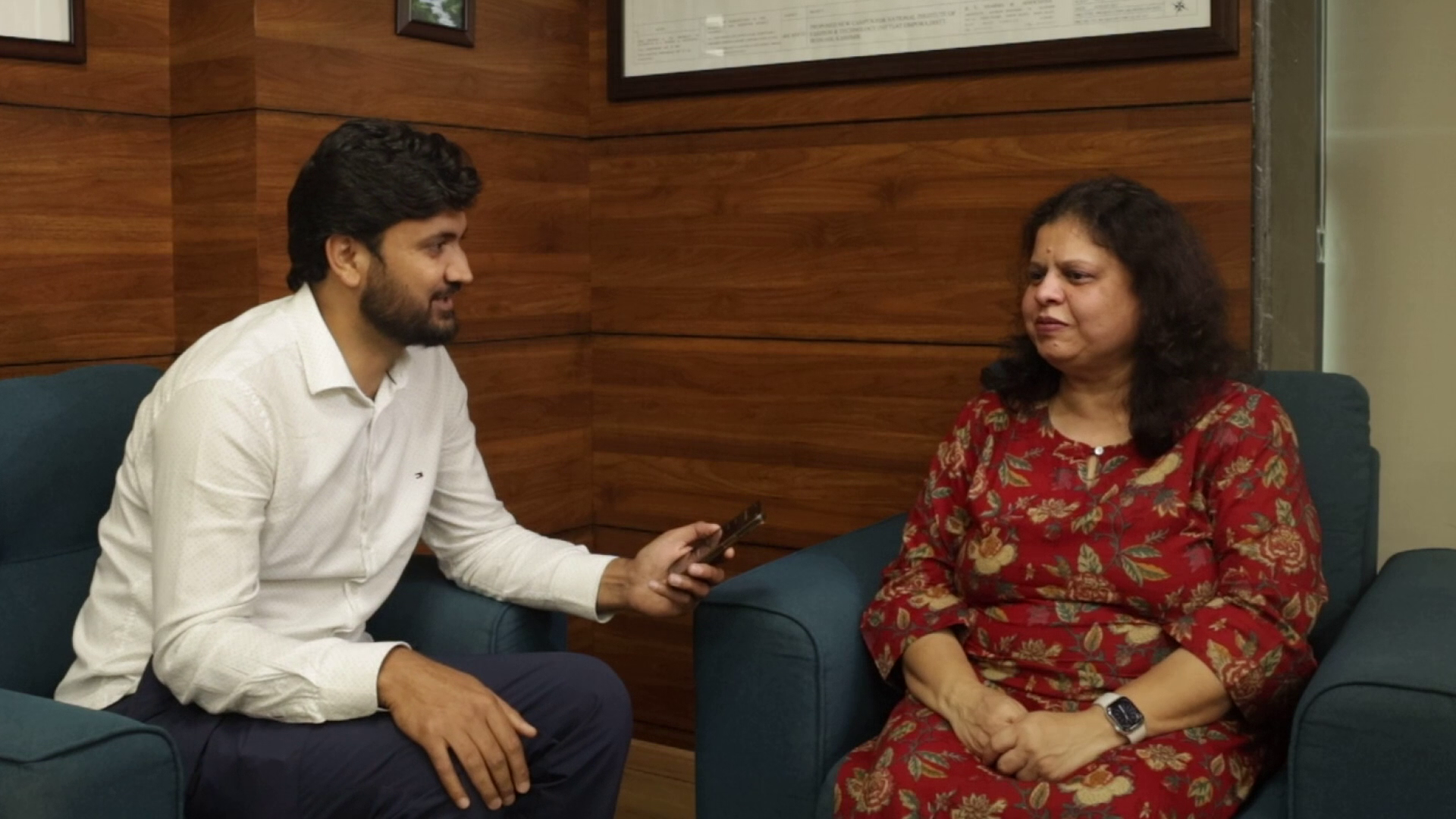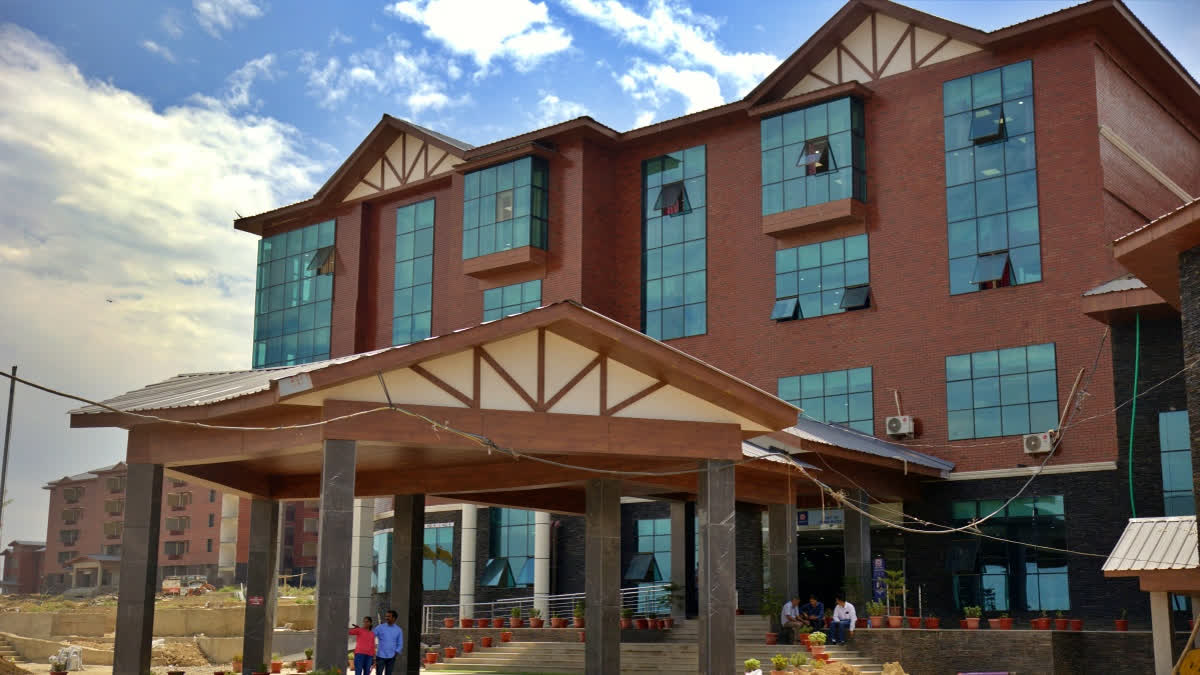Srinagar: Until 2022, management of the National Institute of Fashion Technology (NIFT) would hold its annual convocations at hired government buildings in Srinagar, and its students would choke with the little space and classrooms. But in the past six years of its introduction in Kashmir, NIFT has now grown into a full-fledged institution with its multi-storied, sprawling campus on the hilltop in Budgam.
In a conversation with ETV Bharat, the Director of NIFT, Srinagar, Professor Monika Gupta, spoke about the growth of the institution since its inception and the response of the Kashmir-based students towards fashion as academics and career, and how the institute blends Kashmir’s handicrafts, artisans, and their skills into the academics of the students.

Director of NIFT, Professor Monika Gupta (ETV Bharat)
NIFT in Kashmir
She said, “NIFT was started in 2016 from Rangreth in Srinagar outskirts. By 2022, the institute got its own sprawling campus in Ompura, Budgam, a suburb on Srinagar outskirts. With separate hostels for boys and girls, an auditorium, an amphitheatre and spacious classrooms for the students. This is one of the best NIFT campuses amongst the 19 campuses which we have across India. Infrastructure-wise, we have the best.”
Response from Local Students
According to Professor Gupta, the enrollment from local students from Jammu and Kashmir is less, as the students from the UT prefer outside colleges to NIFT. She said, “We are also promoting; we are getting more students, but some of the students don’t want to stay in Srinagar; they opt for other campuses. We have a very small number of local students. We are still hoping that we get more domicile seats filled.”
“We are reaching out to educational institutions in Jammu and Kashmir, promoting NIFT among the students. Maybe the lower response has to do with the perception of fashion. The message from my side to the locals is, although it is a college, our main focus is on crafts, and we are very pleased to work with the crafts of Kashmir, and we would like artisans to come and work with us. Fashion does not mean that it is only garments,” she added.
Courses offered
NIFT offers five courses. Four are undergraduate courses: Fashion Design, Fashion Communication, Fashion and Lifestyle Accessories, and Textile Designing. A two-year postgraduate course is also offered in Fashion Management. So we have five courses at this time. Our batch size is 40.
For the UG courses, the basic educational requirement is 10+2, for which the entrance exam is held at the national level. For the PG course, any bachelor’s degree is sufficient. The institute has a mix of local and non-local faculty. We are short on faculty. Those are long-term faculty, but from this year, we have been taking short-duration faculty.
Training students for competitive Fashion Industry
Fashion is a very dynamic industry, and everybody has to be up to date. Even the faculties have to keep referring to what is new and what is the latest. So for the students, definitely, we have a certain subscription to certain forecasts. Then there are fashion shows, there are exhibitions, and there are fairs where we send our faculty. They update their knowledge. And otherwise, generally, these are available on social media, and if anybody wants to subscribe to certain things, we allow them. And these are the things which are transmitted to the students.
Removing perception, Convincing local students
Fashion design is a very diverse field. “We don’t offer only fashion design; we also offer other courses. So if students have an inclination towards designing, they can join. It’s a very creative field, and it is just not glamorous; it is a very hard-working field. The student has to be very creative. They can explore whatever is in their mind, they can put it on a ramp or make products out of it or express it in another way,” she said.
“I would say that the fashion industry is very big, and the demand for students in this field is there. So if they have a certain inclination towards garments, towards accessories, towards communication, towards textiles, they should join NIFT,” Professor Gupta added.
Jobs placements
We have centralised placement for all of NIFT, and the students are given chances to appear for the placement, and they can move from one centre to the other center. We have a few hub centres where the interviews are conducted. Some interviews are conducted online, and some are conducted offline. The students can move to four hub campuses for interviews, and all students from all campuses get equal opportunity.
Placement is around 90% for all campuses. It has declined a little bit in the last few years. However, with the improvement in the industry, it is improving. We provide students with an internship of eight weeks during the course.
NIFT offers diplomas
Yes, actually, in the Srinagar campus, the short-duration programs have not been successful. Maybe because of our location, but in other campuses we do offer certificate courses, diplomas. Certificate courses could range from five days to a year, and diplomas are usually two years, and we do customise programs.
Integration of Kashmiri arts into curriculum
Yes, it is already built into our curriculum. So throughout the semesters, we have different craft interactions. So, like we have a craft awareness workshop where the artisan comes to the college and gives a demo, it’s a small talk that is for the first-year students. So they just become aware of what crafts are there in the local artisan industry. Then we run a craft bazaar every year where we invite the craft persons, and they come and display their products. They can give a demo, and they can sell their products.
We have crafted research documentation for 10 days. The students go to the craft person they document the craft and interact with the craft person, and learn the techniques. In the fourth year, basically, the students who went to that craft person will go again and do product diversification for them. And in return, the students also get an idea of the local handicrafts and artisans. This has helped in the percolation of the local art into the fashion industry.
We also do projects where we deal with the artisans. So till now we’ve done a lot of training programs for artisans. For training programs, our faculty can go to a certain area, or we invite the artisans to come here. We even have a 15-day in-house training program for the artisans. So that is for the promotion of local art and also giving the idea to students what local handicrafts and Kashmir handicrafts are all about here. In every project we take students, and they become aware of the things.
We have been understanding what are the problems of the craftsperson, how we can help our students, in promoting them, in working with them and making product diversification.
Your own ideas for NIFT upliftment
“I have been working with NIFT for the last 31 years, and I’ve been in the Delhi campus and which Delhi campus is considered to be the number one position. I’m bringing experience and I would love Srinagar to reach that position one day. My ideas are that we improve the quality of education, to coordinate with the local, local craft, local people. Unless we coordinate with them, the institute cannot grow. To interact with the local other institutes and work towards community building and to do collaborative programs,” she concluded.
Also Read
Employees to don NIFT-designed attires in new Parliament building
Interview | Arunachal Pradesh’s First Fashion Designer Jenjum Gadi Is Taking His Sculpture To The Upcoming Jodhpur Arts Week
link

